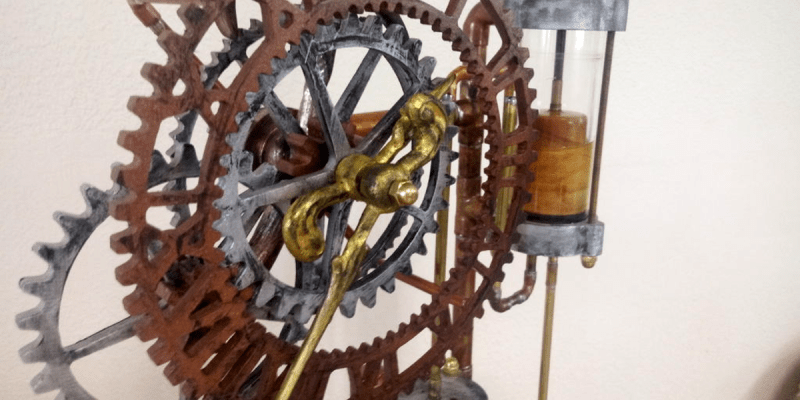The funny thing about clocks is that the more intriguing they are to look at, the more precious time is wasted. This steampunk clepsydra is no exception. A clepsydra, or water thief clock is an ancient design that takes many forms. Any clock that uses the inflow or outflow of water to measure time could be considered a clepsydra, even if it uses electronics like this steampunk version.
[DickB1]’s sticky-fingered timepiece works by siphoning water from the lower chamber into the upper chamber on a one-minute cycle. An MSP430 and a MOSFET control the 12 V diaphragm pump. As the water level rises in the upper chamber, a float in the siphon pushes a lever that moves a ratchet and pawl that’s connected to the minute hand. The hour hand is driven by gears. A hidden magnet and Hall effect sensor help keep the clock clicking at one-minute intervals.
Although [DickB1] doesn’t tell you exactly how to replicate this clock, he offers enough information to get started in designing your own. Take a second to check it out after the break.
Most of the thieving around here is done for the joules, so here’s a joule thief running a clock.
















[Obligatory 555 comment]
[Obligatory 3D printing comment]
[Obligatory Raspberry Pi comment]
thats a novelty, A steam punk device that actually uses the gears it contains – I am impressed.
but that aside it is nice piece of work
Oddly, it may be more consistant over time and temperature than a 555.
Close. But opposite.
> works by siphoning water from the lower chamber into the upper chamber on a one-minute cycle.
vs.
> A steady stream of water fills a chamber, and a siphon periodically drains it.
Auto-siphons are rather interesting. The siphon kicks in when the water level is high enough. They’re used some with aquariums, for high-volume low-noise drains, for emergency kick-in drains, or they can be the mechanism that provides surge flow to a tank (you can even use an air-lift water pump to fill the reservoir…). They can even be used for a water-level triggered high-flow overflow for small dams.
Also Soxhlet extractors for liquid separation of a chemical of interest from (usually plant material) solid material, and arguably a toilet bowl is a partial autosiphon that includes a trap function.
If the upper chamber was being filled by a flowing water source, this could be setup to count the number of times the upper chamber was filled.